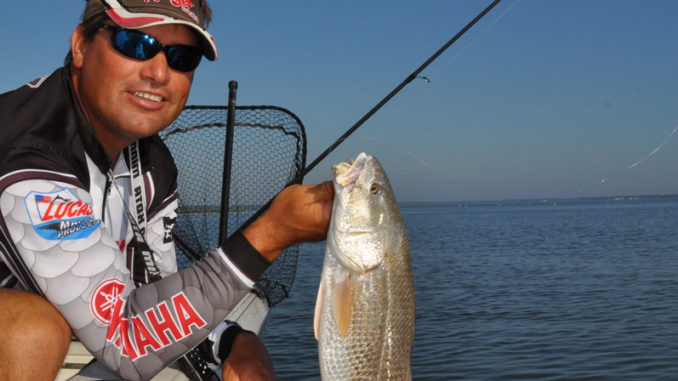
Learn how the moving tides position fish and let your baits to the rest for some great shallow-water fishing.
Capt. Mike Taylor slowed the engine of his bay boat, making sure he did not bang the prop on an oyster bed. The sun was higher than he preferred, but the timing of the high tide was more important than beating the sunrise.
“The key to catching redfish is knowing where to find the fish on a certain tide stage,” he said. “The fish stage outside the grass, then start moving into the grass as water floods in. They move back out to the edges of the grass beds as the tide falls.”
Taylor, who runs Taylor Made Fishing Charters, climbed up into his second helm station, motoring along slowly while watching intently through polarized sunglasses for signs of fish, the extra height and low angle of the sun allowing him to see down into the water for longer distances.
“I see some movement in that little pocket of grass,” he said. “There’s an oyster bed over there.”
Climbing down, Taylor headed for the bow to drop the trolling motor. He fired off several long casts, probing the oyster bed and grassy edge with a soft-plastic lure.
A few mullet jumped, and some menhaden flipped, and then a big wake surged out of the grass. The fish struck hard; Taylor struck back. He played the 25-inch red drum to the boat and lifted it from the water.
“That’s an average-sized fish for this area,” he said, alluding to the backwaters around Morehead City. “They are cookie-cutters, with most of the fish inside the slot size limit of 18 to 27 inches.
“I catch them at North River, Middle Marsh and Core Creek,” he said. “If you are rigged right, you can find fish in some good places and have them all to yourself. We probably will not see another redfish angler this morning. My boat drafts 12 inches of water at rest and runs in 10 inches. With a trolling motor and a shallow-water anchor, you can fish on almost any tide stage.”
Taylor switched out his lures through the morning as he moved along, casting to the cover, catching and releasing redfish. He used several styles of Gulp! soft plastics, and the trick that made them so successful at enticing strikes was the way they were rigged.
“I use a weighted, spring-lock hook,” he said. “The spring holds tight when you screw it into the nose of the lure, and I bury the hook all the way through the body to make it snag-free. If you are hanging up all the time on the oysters and grass, you aren’t going to catch many fish, but you are going to lose lots of lures. I also like to use topwater lures if the fish are really showing some aggression. A redfish striking a Top Dog is one of the most exciting events in all of inshore saltwater fishing.”
Taylor made a cast, felt a strike and set the hook. At the flip of a switch, his Talon shallow-water anchoring device thrust an aluminum shaft down through the water to grab the bottom. The boat stopped moving in an instant.
“I saw some other fish with the one I was playing,” he said. “You don’t want to run over the fish, so you have to be able to stop the boat on a dime. Sometimes you can catch a half-dozen fish or more from one spot as long as you don’t spook them. Moving around all over the boat, dropping a fluked anchor with a chain, then picking it back up makes enough noise to chase away every redfish out within 100 yards. The Talon is almost silent, and it is much simpler to set down and pick up. It works great, even if you are fishing alone.”
Biologist Lee Paramore, the red-drum expert for the N.C. Division of Marine Fisheries, said a good age-class is the reason anglers like Taylor have been experiencing red-hot red drum fishing.
“The red drum in the marshes will range from age-1 to age-3 three,” he said. “When you are catching them in the fall, a 14- to 17-inch fish is age-1, a 20- to 25-inch fish is age-2 and a typical age-3 fish is at the upper-slot size of 27 inches. At age-3, they are approaching the size of maturity and will not frequent the shallow, marshy areas but will instead move offshore to the hard and live bottoms and surf zone. By age-4, 100 percent of the fish reach spawning maturity.”
Paramore said some of the division’s diet studies show red drum are opportunistic feeders, eating crabs, shrimp and fish. However, most of their diets consist of mud crabs, which are prevalent around oyster beds, as well as blue crabs.
“Sometimes the fish will be in large schools and, when they are, they are feeding aggressively,” he said. “Some will stay in the creeks as it turns colder, and some will move out, following food and bait species into the ocean. The age-2 fish move out more than age-1 fish and the age-3 fish move out more than age-2 fish. The age-1 fish will usually remain active in the warmer, shallow-water areas, such as oyster bars, all winter.”
However, good age-classes are not produced every year, due primarily to environmental conditions. Most of the redfish that Morehead City anglers are catching were spawned in 2011, so they will be leaving the marshes soon.
“The 2011 spawn was so good, it was the major factor in some very high angler releases in 2012, followed by very high landings of slot-sized fish in 2013,” he said. “This year, anglers will still be catching those fish. But 2012 was an average or below- average year and early signs from 2013 show it also was not a good spawn, so the 2011 year-class is carrying the fishery. The quality of the fishing will decline next year, based on what we are seeing.”
Paramore said red drum are intensely studied fish. Tagging studies show that Cape Lookout is the population dividing line. Fish north of the cape enter the ocean from Pamlico Sound, Ocracoke and Drum Inlet forming one stock, while those in the Atlantic south of the cape form a different stock.
“Red drum can live 60 years, which helps them maintain their numbers through years of poor recruitment,” he said. “We still need to learn more about them, so we are tagging red drum with conventional yellow and blue tags. If you catch a fish with a red tag, though, you can cut it off and send it to the address on the tag and earn a $100 reward. Some of the red tags have already been turned in, but others are implanted in fish still out there swimming, just waiting for anglers to catch them.”
It cannot be over-emphasized that oyster beds form the largest amount of hard structure that attracts and holds red drum in any shallow marsh. An oyster bed may be only a few square feet, or it may span many acres. The key to finding them is moving around a potential fishing area during a low stage of the tide, when they are most exposed. As the tide rises, the fish move up with the water, and anglers can begin fishing for them over the oyster beds they have found.
Crustaceans and other invertebrates, as well as small baitfish, stick to the oyster beds for safety. Red drum will root in the shell beds for these small sea creatures and may give away their presence by “tailing” when they are feeding.
Casting any old lure into an “oyster rock” can result in frustrating hang-ups and cut-offs. A lightweight lure rigged to be snag-free is one of the best types to try. Taylor rigs his soft-plastics son a weighted, spring-keeper hook; the rig is light enough that it trips over the top of an oyster rock, and the weedless hook tends to keep it out of trouble.
Another bait that’s dynamite fished over oyster rocks, and in general around marsh habitat, is a walk-the-dog topwater lure such as a MirrOlure Top Dog. Topwater baits are excellent to cast in shallow situations because they don’t snag submerged cover. They can be cast long distances and worked above and around structure such as sunken boats, riprap, oyster rocks and sandbars.
The key to using a walk-the-dog lure is to keep it coming. The lure flip-flops from side to side at the twitch of a rod tip, mimicking a wounded mullet. The motion and commotion can attract redfish from extremely long distances in shallow water areas and pop up puppy drum that are lurking in deep creek channels.
Often, an entire school of redfish will follow the lure until, suddenly, one of them strikes it. The angler must wait until he feels the weight of the fish before setting the hook or he risks pulling it away from the fish. The fish will also lose interest if the lure stops moving. If the angler steels his nerves and keeps the lure coming, the fish may strike it several times and may even following it all the way to the boat before the angler can sink the hook and the fish finally gets the point.
DESTINATION INFORMATION
HOW TO GET THERE/WHEN TO GO — Morehead City is most-easily accessed by taking US 70 from points west. A popular public boat ramp is behind the Crystal Coast Visitors Center and N.C. Division of Marine Fisheries headquarters on US 70, two miles past its intersection with NC 24. September and October are prime months for fishing the marshes and backwaters around Morehead City, Atlantic Beach and Beaufort because the water is very clear.
BEST LURES/TECHNIQUES — Rig a Gulp! or other soft-plastic bait that imitates a minnow, shrimp or crab on a weighted, spring-lock hook like Daiichi’s “Butt Dragger.” Also, MirrOlure Top Dogs or other walk-the-dog topwaters can be very productive. Fish them on medium-action spinning or baitcasting tackle, spooling reels with 20-pound braid. Some fishermen tie on a short length of fluorocarbon leader; some tie directly to the lure.
FISHING INFO/GUIDES — Capt. Mike Taylor, Taylor Made Fishing Charters, 252-725-2623. See also Guides and Charters in Classifieds.
ACCOMMODATIONS — Crystal Coast Travel and Tourism 252-726-8148, Quality Inn 252-247-3434, Hampton Inn 252-240-3100, Holiday Inn Express 252-247-5001, Doubletree Inn 252-240-1155, Windjammer Inn 252-247-7123, AmeriSuites 252-247-5118.
MAPS — Capt. Segull’s Nautical Charts, 888-473-4855, www.captainsegullcharts.com; Sealake Fishing Guides, 800-411-0185, www.thegoodspots.com; DeLorme North Carolina Atlas and Gazetteer, 800-452-5931, www.delorme.com; GMCO Chartbook of North Carolina, www.gmcomaps.com.

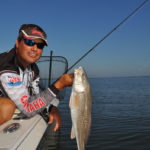
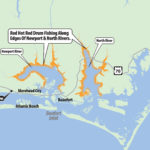
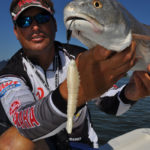
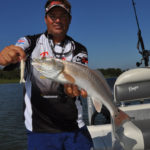
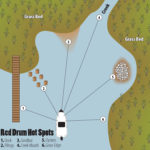

Be the first to comment